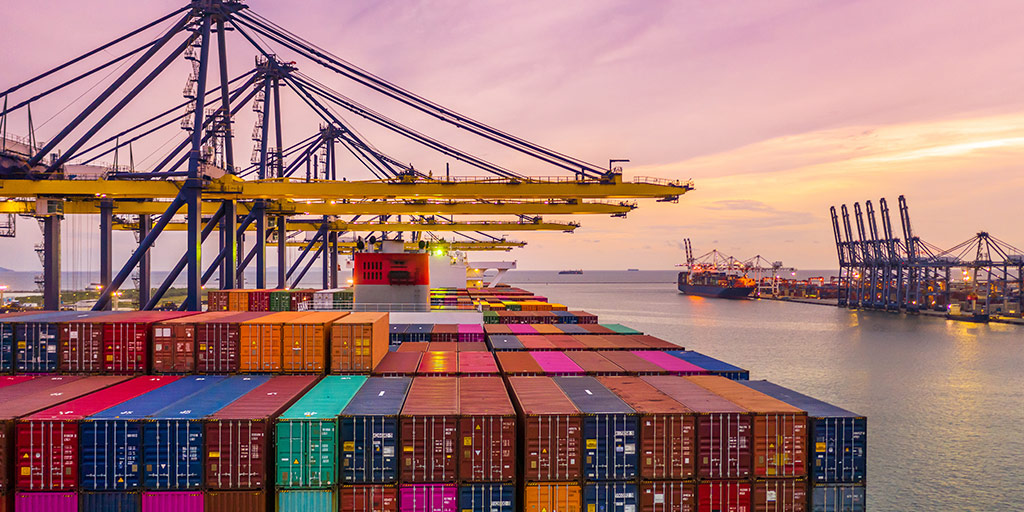Shipping Container Shortages: 2022 and Beyond
Apr 18th 2022
Shipping Container Shortages Persist in 2022
Shipping containers are the essential building blocks of modern manufacturing, retail, import, export, house moves, and general quality of life. Due to the shipping container shortage, many of these have seen a negative impact as containers are harder to both buy and rent. How much longer will the shipping container shortages last?
How Did It Come to This?
Most people fault the pandemic as the event pushing an already fragile global supply chain network into a breaking point. However, it was many worldwide events combined that produced the conditions for port congestion and container shortage. Supply chain disruption has a cumulative effect worldwide, which results in shipping shortages in surprising areas.
Responses to COVID-19 resulted in lockdowns, layoffs, reduced manufacturing, and reduced work in both transport and ports. Throw in a switch in demand from stay-at-home consumers wanting home gym equipment, electronics, and goods rather than services, and you have a surge in the desire for imported goods. This shift in demand meant that more shipping containers in Asia were necessary to send the goods overseas.
Simultaneously, most shipping containers were in the wrong place. Labor shortages (warehouse staff, port staff, and truck drivers) and a scarcity of warehouse and dock space resulted in ships held off the coast acting as floating warehouses because of the port congestion.
Now the cargo flowing in from the sea can't flow out to customers because there are more shipping containers than the ports can handle with their staff and equipment. The cargo coming in to go out to sea can't move because there is no capacity to process it. This situation turned into port congestion around the globe with a significant backlog of essential supplies.
What is the Current State of Ports in California?
In March 2022, the California ports are getting their head above water. Although container transit time is not back to pre-pandemic levels, the situation is improved.
The port authorities suggested dwell charges to encourage cargo owners to move their goods. This threat got the cargo moving, freeing up more space in practice and helping to drive the reduction in port congestion. The Chinese New Year gave a lull in new deliveries allowing the cargo handlers to process as many containers as possible to reduce the backlog.
Currently, congestion in California ports is at a six-month low. The situation isn't ideal but it is improving through better procedures and temporarily diverting some cargo to other ports.
What is the Current State of Ports in China?
China operates on a zero-tolerance policy towards COVID-19 and is currently dealing with an Omicron outbreak. Lockdowns in these port cities due to coronavirus results in manufacturing reductions and container shortages. Ships are also unable to unload or reload cargo because of these restrictions as well as a lack of port staff.
During the last outbreak in China, the ports closed. In the current Omicron outbreak, the ports are trying to continue work but the ongoing lockdowns are creating a backup of containers as truck drivers are unable to gain access to the ports fast enough to move them out.
What Factors Impact Port Congestion
The drivers for port congestion include:
| Increase in Cargo Ship Sizes | Shortage of Trucks and Drivers |
|---|---|
 |
 |
| For a shipping company, it makes sense to increase the size of their cargo ships to carry more containers. Unfortunately, these larger ships can't dock at every port. Port infrastructure needs an upgrade (dredging, more warehouse space, better systems, better equipment, and specialist staff) to cope with larger shipping sizes. Closing a busy port to upgrade the infrastructure creates bottlenecks at other ports and the issue of port congestion increases. | Ideally, you unload a shipping container onto a truck chassis, and the shipping container drives out of the port. Currently, shipping containers take up space on the dock while waiting for transport. The domino effect of containers not exiting the port means that California exports can't get in to be loaded on the ships. The pinch point is a shortage of truck drivers from retirement without replacements, plus a shortage of new trucks. Even the parts necessary for constructing new trucks face delays because of port congestion. |
| Shortage of Space | Container Shortage |
|---|---|

|  |
| If you can't clear the containers out of your port, you end up needing more space for storage. If you run out of room to unload shipping containers, you need to leave the ships outside the ports acting as floating warehouses. Combine a shortage of warehouse space for incoming and outgoing containers with a lack of truck drivers and trucks, and you end up with a bottleneck in the smooth flow of shipping containers in and out of ports. | Exporting your goods means you need shipping containers. Current container costs and trade imbalance between the US and China may mean it is more profitable for shipping companies to take empty containers back to Asia rather than wait around for those containers to refill. This creates a lack of containers for people to rent and buy for their own use. |
| Increased Demand |
|---|
| Economists and other analysts thought lockdown meant less spending. In reality, people stuck at home, working remotely, still had money to spend and the demand for goods to make lockdown bearable caught everybody by surprise. If you can't eat out, you may want to upgrade your kitchen appliances so eating in is more creative and enjoyable. If you can't go to the gym, an exercise bike and some free weights may be desirable. During a lockdown, peoples' habits change, and if you invest in a home gym, why go back to a gym membership? |
The demand for goods rather than services remains after the pandemic subsides and retailers rush to adapt to a new commercial reality of shopping online for more goods to equip home offices and entertainment.
An increase in demand means more containers arriving at busy ports, and the continued container shortage delays delivery times. If you want a new washing machine, you may have to wait a couple of weeks instead of a couple of days.
Will China's Increasing Production Help?
Currently, China is responsible for producing around 80% of all shipping containers. China is now producing more shipping containers, but it isn’t a significant increase as manufacturers don't want to create an oversupply of product by responding too rapidly to what may be a temporary increase in demand.
China’s increase in production of shipping containers aims to have them be filled in Chinese ports and then be sent out as exports. Typically, most of these containers don't return to China, although rising prices mean taking the empty containers back to China is a more viable and cost-effective option.
Most of the world's shipping containers are piling up in the wrong places, and it will take time to sort out the supply chain disruption.
What About the Future?
It is challenging to predict world events and their impact on the availability of shipping containers. However, there are some factors to consider:
| War in Ukraine | Omicron in China |
|---|---|
 |
 |
| Russia's aggressive invasion of Ukraine means sanctions against trade with Russia. From a shipping container viewpoint, that means fewer containers are going to Russia, which are available to other markets. It also means more aid going to Ukraine, and this feature may involve ships and containers, but only in one direction. A complicating factor is China's involvement with Russia. In 2019, poor relations with China and the pandemic contributed to the poor trading conditions and the resulting shipping container shortage. A breakdown in relations with China over the war in Ukraine may further increase supply chain disruption, including the shipping container shortages. | China is currently dealing with a COVID-19 outbreak, and the effect of Chinese measures to contain the outbreak on port congestion now and in a few months are unknown. Closure of manufacturing and ports in China will give a temporary lull in which California ports can clear their backlog, but the pent-up demand may lead to more port congestion in a few months. |
| Labor Relations | Changing Attitudes |
|---|---|
 |
 |
| The contractual relations between International Longshore and Warehouse Union and the Pacific Maritime Association are due for renegotiation on July 1st of 2022. Delays and disputes may result in supply chain disruption. Ships unable to dock won't be able to offload their shipping containers which will further increase container shortages and raising prices. | When shipping containers flow easily into and out of ports, businesses can reduce their inventory and adopt a just-in-time approach for raw materials, parts, and retail goods. When the supply chain doesn't work smoothly due to container shortage and port congestion, some businesses decide on a different approach – stockpiling. Consumer choices to buy online previously didn't require large warehouses and inventory. Still, higher demand and a need for swift delivery mean E-Commerce needs more warehouses in areas where land is scarce. Changing attitudes may result in a higher demand for shipping containers while businesses build their capacity to store inventory. Manufacturing closer to home may help to decrease demand for containers. |
| When Will the Shipping Shortages Stop? |
|---|
Some analysts are optimistic that trade will return to pre-pandemic levels in 2022. Realistically, with current world events and the shortage of labor and land around ports, you can expect that there may be improvements in 2022, but the current issues with port congestion and supply chain disruption will probably last into 2023. |
Storagecontainer.com Can Help with Your Container Needs
Even though there is a global shortage of shipping containers, Storagecontainer.com is still working to bring you quality storage containers for all your needs. We can answer any questions you may have as well as advise you on any modifications or purchasing options.
Get A Quote Today

